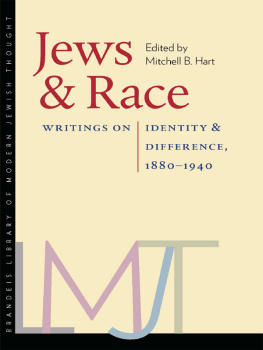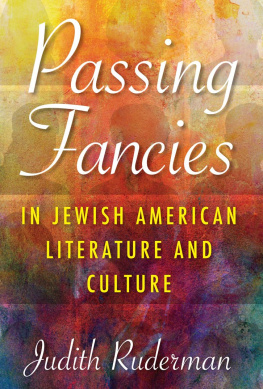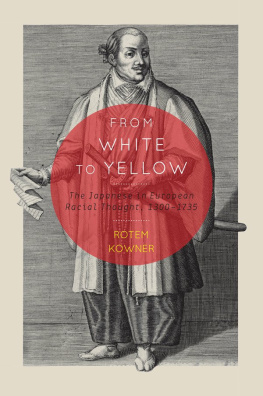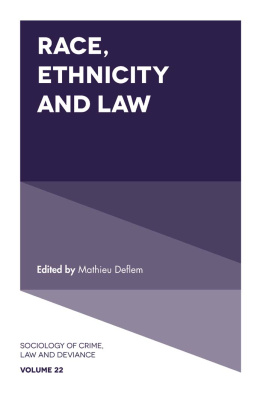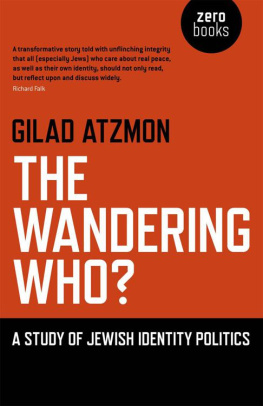THE TAUBER INSTITUTE SERIES FOR
THE STUDY OF EUROPEAN JEWRY
Jehuda Reinharz, General Editor
Sylvia Fuks Fried, Associate Editor
THE BRANDEIS LIBRARY OF MODERN JEWISH THOUGHT
Eugene R. Sheppard and Samuel Moyn, Editors
This library aims to redefine the canon of modern Jewish thought by publishing primary source readings from individual Jewish thinkers or groups of thinkers in reliable English translations. Designed for courses in modern Jewish philosophy, thought, and intellectual history, each volume features a general introduction and annotations to each source with the instructor and student in mind.
Moses Mendelssohn: Writings on Judaism, Christianity, and the Bible
Michah Gottlieb, editor
Jews and Race: Writings on Identity and Difference, 18801940
Mitchell B. Hart, editor
FOR THE COMPLETE LIST OF BOOKS AVAILABLE
IN THIS SERIES, PLEASE SEE WWW.UPNE.COM
Jews
& Race
WRITINGS
ON IDENTITY
& DIFFERENCE,
18801940
Edited by
Mitchell B. Hart
Brandeis University Press
Waltham, Massachusetts
BRANDEIS UNIVERSITY PRESS
An imprint of University Press of New England
www.upne.com
2011 Brandeis University
All rights reserved
For permission to reproduce any of the material in this book, contact Permissions, University Press of New England, One Court Street, Suite 250, Lebanon NH 03766; or visit www.upne.com
Library of Congress Cataloging-in-Publication Data
Jews and race: writings on identity and difference, 18801940 /
Mitchell B. Hart, editor
p. cm.(The Tauber Institute series for the study of European
Jewry) (The Brandeis library of modern Jewish thought)
Includes bibliographical references and index.
ISBN 978-1-58465-716-3 (cloth: alk. paper)
ISBN 978-1-58465-717-0 (pbk.: alk. paper)
ISBN 978-1-61168-030-0 (ebook)
I. JewsIdentity. 2. JewsIdentityHistory19th century. 3. JewsIdentityHistory20th century. 4. JewsSocial conditions19th century. 5. JewsSocial conditions20th century. 6. RaceSocial aspects. 7. Ethnic groups. 8. Physical anthropology. I. Hart, Mitchell Bryan, 1959
DS143.J49 2011
305.8924009041dc23 2011034820
Foreword
It is with great pleasure that we present a volume of the Brandeis Library of Modern Jewish Thought devoted to Jews and racial thinking. Jews were famously the targets of racial thinking in modern times, but they also engaged in it. Mitchell Harts fascinating and unprecedented survey of how they did so offers rich materials for teacher and student to engage this often forgotten chapter of Jewish intellectual history. Across Europe and the United States, as this volume thoroughly documents, Jews wrestled in different ways with the rise of this new scientific category, which assumed the status of a pervasive orthodoxyone that is now thankfully a relic of the past. Harts compilation, which is augmented by a wonderfully illuminating introduction, focuses on the sciences, but it is relevant to political theory as well. The volume helps expand the meaning of modern Jewish thought, which was the preserve of anthropologists and statisticians as much as it was of the perennial thinkers that our other volumes address.
Eugene R. Sheppard and Samuel Moyn, Editors
The Brandeis Library of Modern Jewish Thought
Acknowledgments
It is a pleasure to be able to thank the individuals and institutions that helped me complete this project. The generosity of Mr. Alexander Grass (zl), who established the Alexander Grass Chair in Jewish History at the University of Florida, has allowed me the time and resources necessary to research, translate, and write. I am grateful to the staffs of the libraries at Columbia University, the Center for Jewish History in New York City, the New York Public Library, and the University of Florida for their assistance. Thank you to Shaina Hammerman for her fluid translations from the French. I owe an enormous debt of gratitude to Alexander von Thun, at Columbia University, for his assistance with the German translations. He has saved me from what would have been numerous embarrassing mistakes. My gratitude to Samuel Moyn and Eugene Sheppard for allowing this book to appear in their series, and to Sylvia Fuks Fried and Jeanne Ferris for their editorial assistance. Finally, as always, thanks to Nina for everything else.
Jews and Race
An Introductory Essay
Mitchell B. Hart
The well-known Israeli writer A. B. Yehoshua insisted some years ago that Jews are not a race and never viewed themselves as such.
The status of the Jews as a race surely depends in part on the ontological and epistemological status of races in general. If science tells us that races do not exist, then the Jews cannot be a race. On the other hand, to invert Kaplans question, if there are races, can the Jews be a raceor, more precisely, a genetic community? Certainly many Jews as well as non-Jews continue to employ some sort of racial or quasi-racial language when they think and speak about Jewish identity (and many others, of course, reject such language). Many Jews in the past considered themselves members of a distinct race, one characterized by both positive and negative features. And Jewish thinkers employed the language and images of race to think about the Jewish past and present. Thus, Yehoshuas assertion that the Jews never understood themselves as a race is, despite what many wish to believe, patently incorrect.
The collection of source material that makes up this volume is but a small sample of a large group of texts, written by Jews about Jews, that engaged the vexed question of Jews and race. These are texts written in a number of languages and in different contexts, by Jewish scholars and community leaders living in different countries. Their work was published in a variety of media: in books, academic and popular journals, newspapers, and magazines. It was aimed at both Jewish and non-Jewish audiences. Although the differences among these Jewish thinkers and writers were surely important, it is nonetheless possible to identify a common set of questions and issues that drove their inquiries into the Jewish race.
Are the Jews a race? If so, are they a pure race? If so, what accounts for this purity? If not, which of the various racial branches contributed to the makeup of the Jewish race? Do the Jews possess particular, even unique, traits or qualities that set them apart from other groups? If they do, what accounts for these traits? Are they biological and hereditary, or cultural and environmental? Are they the product of a Jewish nature or essence, or the vicissitudes of historical and contemporary external forces?
These broad, foundational questions led, in turn, to more specific questions. If the Jews are a race, then what is the impact of assimilation on the collective Jewish body and mind? Is intermixtureincluding intermarriagewith other races and peoples a boon, or does it produce decline and degeneration in the Jews? Do Jews suffer from certain illnesses more than other people? Are Jews immune to certain disorders? Are they prone to certain types of criminal behavior and other social pathologies? Are they naturally an urban rather than a rural or agricultural people? Are Jews predisposed to certain occupations or economic systems, such as capitalism?
How much does Judaism have to do with shaping the Jews physically and mentally? What, in other words, does religion have to do with race? and thus kept their blood relatively pure from foreign influence (to phrase the question in the terms that were used much of the time)? Or is the historical reality different from the religious and cultural demand and expectation? Is endogamy a healthy or unhealthy practice, considered from a racial and eugenic viewpoint? Does it lead, for example, to a decline in fertilitythat is, to fewer and unhealthier offspring? Many scientists believed this was the case, and as the selections included in part 5, Racial Mixing, illustrate, Jewish racial thinkers took up this question in their own work.

